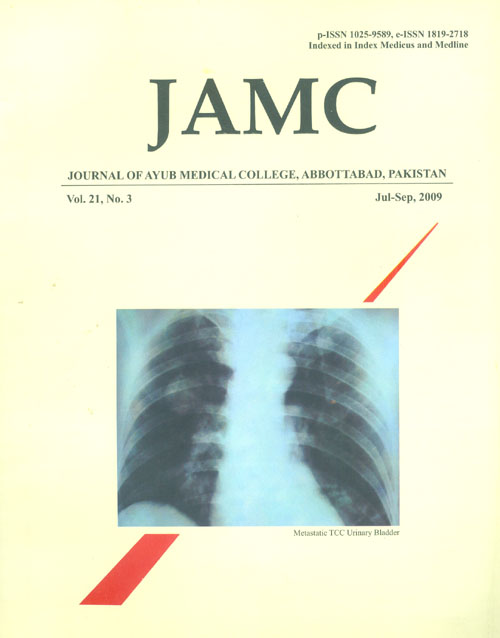RELATION OF HYPERTENSION WITH BODY MASS INDEX AND AGE IN MALE AND FEMALE POPULATION OF PESHAWAR, PAKISTAN
Abstract
Background: Hypertension, a condition developed as a result of high blood pressure is stronglycorrelated with body mass index (BMI). Obesity was noted to be a single best predictor ofhypertension incidence, and was regarded as a major controllable contributor to hypertension.Overweight and obesity is conveniently determined from BMI. Present study was conducted inKhyber Medical College (KMC) Peshawar to investigate the relation of hypertension with BMIand age. The objective of the present investigation is to establish a relationship betweenhypertension and BMI in male and female population of Peshawar with consideration of age.Methods: This study was conducted at KMC, Peshawar during 2008–2009. A total of 1006 adultmale and female volunteers were the subject of present research and were categorised in terms oftheir ages. BMI was determined from weight and height; the subjects were grouped as normal,overweight and obese. Hypertension was determined from the measure of blood pressure. Results:The results show a consistence relation between BMI and hypertension within age groups in bothmale and females. The figures exhibited a relation of age with BMI and hypertension in bothmales and females subjects. Conclusion: The results showed a higher trend of hypertension withincreasing BMI. In young females it was noted that with a shift from normal BMI the incidence ofhypertension was very high.Keywords: Hypertension, BMI, blood pressureReferences
Obesity: Mosby’s Dental Dictionary, 2nd edition, 2008,
Elsevier Inc.
Grundy SM and Nicola Abate, “Obesity”. Chapter 2,
Secondary Heart Disease (Systemic Diseases and The Heart)
,CAR–S8 02(1463-1468). Available at:
http://www.cardiologytext.com/common/showimage.cfm?typ
e=s&ThisFigFile=/suppfiles/chapter2.pdf
Majid Ezzati, Martin H, Skjod S, Hoorn SV. Trends in
National and State-Level Obesity in the USA after correction
for self-report bias: Analysis of Health Surveys. J R Soci
Med 2006;99:250–7.
Jafar TH; Chaturvedi N, Papps G, Prevalence of Overweight
and Obesity and their Association with Hypertension and
Diabetes Mellitus in an Indo-Asian Population. CMAJ
;175:1071–7.
International Obesity Task Force Press Statement (embargo
Monday August 25 2003–1 pm BST). Available at:
www.iotf.org/media
Malnick SDH, Knobler H. The Medical Complications of
Obesity. Q J Med 2006;99:565–79.
Ghosh JR, Bandyopadhyay AR. Comparative Evaluation of
Obesity Measure: Relationship with Blood Pressures and
Hypertension. Singapore Med J 2007;48(3):232.
Clinical Guidelines on the Identification, Evaluation and
Treatment of Overweight and Obesity in Adults. NIH
Publication No. 98–4083, September 1998.
Low S, Chin MC, Ma S, Heng DM, Deurenberg-Y. Rationale
for Redefining Obesity in Asians. Review Article Ann Acad
Med Singapore 2009;38:66–74.
Brown CD, Higgins M, Donato KA, Rohde FC. Body Mass
Index and the Prevalence of Hypertension and Dyslipidemia.
Obesity Research 2000;8:605–619.
Tassaduqe K, Ali M, Salam A, Latif M. Hypertension in
Relation to Obesity, Smoking, Stress, Family History, Age
and Marital Status among Human Population of Multan, Pak
J Med Sci 2004;35:30–5.
Huang Z, Willet WC, Manson JE, Rosner B. Body Weight,
Weight Change and Risk for Hypertension in Women. Ann
Int Med 1998;128(2):81–8.
Hu FB, Willett WC, Li T, Stampfer MJ. Adiposity as
Compared with Physical Activity in Predicting Mortality
among Women. N Engl J Med 2004;351:2694–703.
Mertens IL, Van Gaal LF. Overweight, Obesity and Blood
Pressure: The Effect of Modest Weight Reduction, Obesity
Res 2000;8:270–8.
Published
Issue
Section
License
Journal of Ayub Medical College, Abbottabad is an OPEN ACCESS JOURNAL which means that all content is FREELY available without charge to all users whether registered with the journal or not. The work published by J Ayub Med Coll Abbottabad is licensed and distributed under the creative commons License CC BY ND Attribution-NoDerivs. Material printed in this journal is OPEN to access, and are FREE for use in academic and research work with proper citation. J Ayub Med Coll Abbottabad accepts only original material for publication with the understanding that except for abstracts, no part of the data has been published or will be submitted for publication elsewhere before appearing in J Ayub Med Coll Abbottabad. The Editorial Board of J Ayub Med Coll Abbottabad makes every effort to ensure the accuracy and authenticity of material printed in J Ayub Med Coll Abbottabad. However, conclusions and statements expressed are views of the authors and do not reflect the opinion/policy of J Ayub Med Coll Abbottabad or the Editorial Board.
USERS are allowed to read, download, copy, distribute, print, search, or link to the full texts of the articles, or use them for any other lawful purpose, without asking prior permission from the publisher or the author. This is in accordance with the BOAI definition of open access.
AUTHORS retain the rights of free downloading/unlimited e-print of full text and sharing/disseminating the article without any restriction, by any means including twitter, scholarly collaboration networks such as ResearchGate, Academia.eu, and social media sites such as Twitter, LinkedIn, Google Scholar and any other professional or academic networking site.









